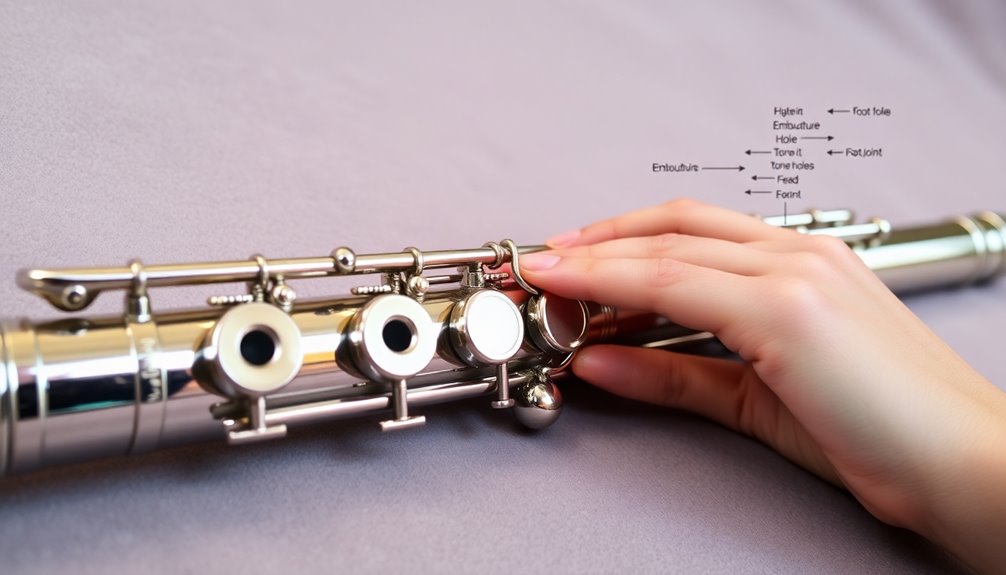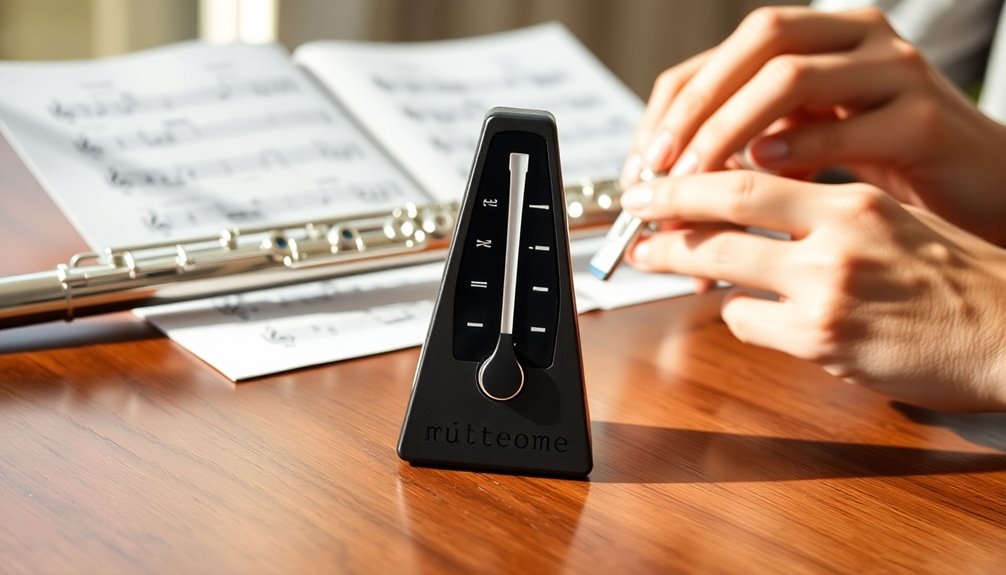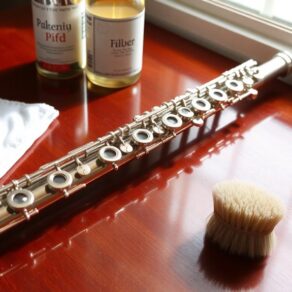To kickstart your journey as a beginner flute player, start by choosing the right flute that feels comfortable and sounds good. Master proper posture and focus on breath control to improve your tone. Familiarize yourself with fingerings and practice regularly to build muscle memory. Use a metronome to enhance your timing, and don't hesitate to explore simple songs to keep things fun. Joining a community can provide support and inspiration. Set specific goals to track your progress, and celebrate your milestones along the way. If you're ready to learn more, there's a wealth of tips waiting for you!
Key Takeaways
- Choose a flute made from quality materials, such as silver or nickel silver, for better sound and durability.
- Develop proper technique through consistent practice of posture, breath control, and finger placement to produce clear notes.
- Establish a structured practice routine with set goals, daily time allocation, and the use of a metronome to track progress.
- Engage with local or online flute communities to share experiences, participate in workshops, and find mentorship opportunities.
- Stay motivated by celebrating achievements, exploring diverse music genres, and reconnecting with your passion for playing the flute.
Choose the Right Flute

When it comes to choosing the right flute, you'll want to contemplate several key factors that can make a significant difference in your playing experience.
First, consider the flute materials. Most beginner flutes are made from nickel silver, which is durable and affordable. However, if you're looking for a warmer tone and enhanced responsiveness, you might explore options made from silver or even a silver-plated finish. Each material affects the sound quality and playability, so it's important to test a few.
Next, think about flute brands. Some reputable brands like Yamaha, Gemeinhardt, and Trevor James offer a range of flutes for beginners. Each brand has its unique features and advantages, so you may want to play a few different models to find what feels comfortable in your hands. Popular beginner brands like Yamaha and Gemeinhardt are often recommended by music educators for their quality and reliability.
Look for a flute that feels balanced and allows you to easily reach all the keys. Don't hesitate to seek advice from music educators or experienced players; they can offer invaluable insights based on your specific needs.
Remember, it's not just about the price tag; investing in a quality flute can enhance your learning journey and keep you motivated.
Lastly, consider where you'll be playing. If you're joining a band or an ensemble, you might want to ascertain your flute blends well with others.
Understand Flute Anatomy

Understanding flute anatomy is fundamental for every beginner flutist. Familiarizing yourself with the various flute parts helps you play better and guarantees your instrument stays in top shape. Your flute consists of three main sections: the headjoint, body, and footjoint.
The headjoint houses the embouchure hole, where you blow air to produce sound. Experimenting with your embouchure will help you find the best angle for a clear tone. Proper embouchure technique is essential for producing an optimal sound.
Next, the body contains the key mechanisms that allow you to play different notes. It's essential to know where each key is located so you can navigate your music with ease.
Finally, the footjoint contains additional keys that expand your flute's range, often used in more advanced playing.
Now that you know the parts, let's talk maintenance tips. Regular cleaning is crucial to prevent moisture buildup, which can damage your flute. Use a cleaning rod and soft cloth after each session to wipe away moisture, especially from the pads under the keys.
Inspect the pads for wear and replace them as needed to guarantee your flute plays smoothly.
Understanding your flute's anatomy and caring for it properly won't only enhance your playing experience but also foster a deeper connection with your instrument.
Master Proper Posture

Mastering proper posture is essential for playing the flute effectively and comfortably. Good posture not only enhances your flute alignment but also promotes body relaxation, allowing you to focus on producing beautiful music. Here are some key points to keep in mind:
| Aspect | Description | Tips for Improvement |
|---|---|---|
| Feet Position | Stand with your feet shoulder-width apart. | Distribute your weight evenly. |
| Back and Neck | Keep your back straight and neck relaxed. | Imagine a string pulling you up. |
| Arm and Hand Angle | Position your arms slightly forward, elbows relaxed. | Keep your wrists straight and fingers curved. |
When your feet are firmly grounded, it creates a stable base for your entire posture. Keeping your back straight helps you breathe more easily, while relaxing your neck releases tension. Make sure your arms are at a comfortable angle, as this not only affects your flute alignment but also influences your ability to play fluidly. Additionally, maintaining proper posture supports effective breath control and enhances your overall musical expression.
Develop Breath Control

How can you effectively develop breath control for flute playing? Mastering breath control is essential for producing a beautiful tone and sustaining notes, and it all starts with the right breath exercises and diaphragm strengthening. By focusing on your breath, you'll not only improve your flute skills but also build a strong foundation for your musical journey.
Begin with simple breath exercises. One effective method is to practice inhaling deeply through your nose, allowing your abdomen to expand. Hold for a moment, then exhale slowly through your mouth, feeling your diaphragm engage. Repeat this process several times, gradually increasing the duration of your exhale. This not only strengthens your diaphragm but also teaches you to control your airflow.
You can also incorporate long tones into your practice. Choose a note and play it as steadily as possible, focusing on maintaining a consistent sound. This exercise will challenge your breath control and help you develop a sense of timing.
Additionally, try varying the dynamics—start softly and gradually increase your volume, then decrease it back to a soft sound. This will enhance your ability to manipulate your breath while playing. To further improve your control, practice exercises like long tones and intervallic scales that strengthen your respiratory muscles.
Learn Basic Fingerings

With improved breath control under your belt, it's time to focus on another fundamental aspect of flute playing: learning basic fingerings. Mastering finger placement is essential for producing clear notes and developing a smooth sound. You'll want to familiarize yourself with fingering charts, which visually represent the keys you'll need to press for each note. This will make your practice sessions more effective and enjoyable. Remember that using a closed-hole flute can simplify the fingering process for beginners.
Start by practicing the fingerings for the first five notes of the flute scale: B, A, G, F#, and E. Here's a simple chart to help you visualize these fingerings:
| Note | Finger Placement | Fingering Chart |
|---|---|---|
| B | 1 2 3 4 5 |  |
| A | 1 2 3 4 |  |
| G | 1 2 3 |  |
| F# | 1 2 4 |  |
| E | 1 2 |  |
As you practice, pay close attention to your finger placement. Verify your fingers are relaxed and hovering just above the keys, ready to move quickly. Don't rush; take your time to develop muscle memory. You're building a strong foundation for your flute journey, so embrace each step!
Practice Scales Regularly

Practicing scales regularly is one of the best ways to improve your flute playing. Scale exercises help you develop your technique, finger dexterity, and overall musicality. By incorporating scales into your daily practice routine, you'll gain a better understanding of musical structures and improve your ability to navigate different pieces.
Start by mastering simple scale patterns, like major and minor scales. Focus on playing them slowly and accurately. As you get comfortable, gradually increase your speed. This approach not only enhances your finger agility but also builds your confidence.
Remember, it's crucial to practice both ascending and descending scales to establish a well-rounded skill set. Regular practice fosters muscle memory and emphasizes the importance of repetition for skill enhancement.
Consider setting specific goals for your scale practice. For example, dedicate a few minutes each session to different scale exercises. You can alternate between various keys or focus on challenging patterns that push your limits. Tracking your progress can also keep you motivated.
Don't hesitate to explore different resources, such as books or online tutorials, to find new scale exercises that resonate with you. You're part of a community of flute players, and sharing tips or experiences with fellow musicians can enhance your learning journey.
Finally, be patient with yourself. Improvement takes time, and regular scale practice will yield results. Celebrate your progress, no matter how small, as each step brings you closer to becoming a more skilled flutist.
Embrace the process, and enjoy the music you create!
Focus on Tone Quality

A rich, resonant tone is essential for any flutist looking to elevate their playing. Focusing on tone quality from the beginning will set you on a path to becoming a more expressive musician. To achieve this, you'll need to pay attention to your tone production. Start by experimenting with your embouchure—the way your lips shape the air as it enters the flute. Small adjustments can make a big difference.
When you place your lips on the flute, aim for a firm yet relaxed position. This balance allows for better airflow and helps produce a fuller sound. You might need to adjust the angle of your head joint or the position of your lips to find what works best for you. Don't be afraid to try different placements; each small change can lead to improvements in your tone quality.
Also, remember to breathe deeply and support your airflow with your diaphragm. Consistent, controlled airflow is key to producing a steady, rich tone. Practice long tones regularly. Start with a comfortable pitch and hold it, focusing on maintaining an even sound. As you get more comfortable, increase the length of time and the range of notes you practice. Additionally, understanding breath support is crucial for mastering flute playing, as it impacts your overall performance quality.
Finally, listen to recordings of accomplished flutists. Pay attention to their tone quality, and try to emulate what you hear. Surrounding yourself with great sounds can inspire you and give you a sense of belonging in the flute community.
Embrace the journey of developing your tone; it's a rewarding process that enriches your playing!
Use a Metronome

Using a metronome can greatly enhance your playing skills and help you develop a strong sense of timing. This essential tool keeps you accountable to the rhythm, allowing you to focus on your flute technique while ensuring that you're staying on beat. By incorporating metronome techniques into your practice sessions, you'll find that your tempo consistency improves markedly.
Start by setting your metronome to a slow tempo. This helps you play each note clearly and accurately without feeling rushed. As you become comfortable, gradually increase the tempo. This progressive approach will build your confidence and allow you to tackle more complex pieces over time. Remember, the goal isn't just to play faster; it's about playing cleanly and accurately at any speed.
Incorporate the metronome into various exercises, such as scales or long tones. This helps you internalize the rhythm and reinforces your timing. Don't hesitate to experiment with different time signatures and subdivisions, as this will broaden your rhythmic understanding and flexibility. Additionally, using a flute tuner alongside your metronome can ensure that your pitch remains spot on while you practice.
If you ever feel frustrated, take a moment to recalibrate. It's perfectly normal to struggle with tempo consistency in the beginning. Celebrate your progress, no matter how small, and remind yourself that every musician has been where you're now.
Explore Simple Songs

As you build your timing skills with a metronome, exploring simple songs can be a rewarding next step. Playing easy melodies not only boosts your confidence but also helps you connect with the music in a meaningful way. Choose popular tunes that you enjoy; they're often easier to learn and can be more motivating. You'll find that familiar melodies make practicing feel less like a chore and more like fun.
Start with well-known children's songs or folk tunes. Classics like "Twinkle, Twinkle, Little Star" and "Mary Had a Little Lamb" are perfect for beginners. These easy melodies typically use a limited range of notes, allowing you to focus on your breath control and finger positioning.
Once you feel comfortable with these, challenge yourself with slightly more complex pieces. As you explore, don't hesitate to experiment with different tempos. Slowing down a favorite tune can help you master tricky sections, while playing faster can enhance your timing skills. Incorporating Disney songs(https://disney.com) into your practice can also make learning more enjoyable and engaging.
Remember, it's perfectly okay to make mistakes along the way; they're part of the learning process! You might also consider recording yourself as you play. Listening back can provide insights into areas for improvement and help track your progress.
Ultimately, the more you practice these simple songs, the more you'll enjoy your flute journey. Embrace the joy of making music, and remember, each note you play brings you one step closer to becoming the flutist you aspire to be.
Join a Community

Joining a community can greatly enhance your flute learning experience. Connecting with fellow flute players, whether through local groups or online forums, provides motivation, support, and valuable resources. You're not alone in your journey; there's a whole world of musicians enthusiastic to share their experiences and tips.
Start by seeking out local groups in your area. Many music schools or community centers offer classes or meetups for flute players of all levels. Engaging with these groups allows you to learn from others, share your progress, and even perform together. The camaraderie you'll find in a local setting can be immensely encouraging, especially when you face challenges.
If in-person options aren't available or convenient, don't worry! Online forums are a fantastic alternative. Websites like Reddit or specialized music forums host passionate communities where you can ask questions, share your journey, and receive constructive feedback.
You'll discover a wealth of resources, including tutorials, sheet music, and practice tips tailored to beginners like you. Additionally, participating in community events can provide opportunities to practice proper posture and develop essential techniques that improve your overall playing.
Participating in a community also opens the door to friendship. You'll meet people who share your passion and understand the ups and downs of learning an instrument. These connections can help keep you motivated and inspired to practice regularly.
Frequently Asked Questions
How Long Does It Take to Learn the Flute?
Learning the flute varies for everyone, but your practice duration and learning pace play a big role.
If you dedicate consistent time each week, you might start playing simple songs within a few months. Typically, it takes about six months to a year to feel comfortable with basic techniques.
What Are Common Mistakes Beginners Make?
Learning the flute is like crafting a delicate sculpture; it requires precision and patience.
Common mistakes you might make include struggling with embouchure issues, which can hinder your sound quality, and incorrect finger placement that affects your speed and accuracy.
Don't worry; everyone starts somewhere! Focus on your technique, practice regularly, and soon you'll find your rhythm.
Embrace the journey, and remember, every musician was once a beginner just like you.
Should I Rent or Buy a Flute?
When deciding whether to rent or buy a flute, consider your commitment level.
Renting options offer flexibility, allowing you to explore your interest without a big upfront cost.
However, buying advantages include owning a quality instrument that grows with you.
If you're serious about playing, investing in a flute can enhance your experience.
Ultimately, choose what feels right for you, and remember, every musician finds their path at their own pace!
How Often Should I Practice?
You might feel overwhelmed, wondering how often to practice, but striking a balance is key. Aim for at least 30 minutes a day, five days a week.
This practice frequency helps you build effective routines without burning out. Mix in warm-ups, scales, and pieces you enjoy to keep it fun.
Can I Learn Flute Without a Teacher?
Absolutely, you can learn the flute without a teacher! Many people successfully use self-teaching methods and online resources.
Start by exploring tutorial videos and interactive apps that guide you through the basics. Join online forums or social media groups to connect with fellow learners, share progress, and seek advice.
Conclusion
To sum up, starting your flute journey can be incredibly rewarding. Did you know that nearly 80% of beginner musicians who practice regularly find greater enjoyment in playing? By choosing the right flute, mastering posture, and developing breath control, you're setting yourself up for success. Keep exploring songs and engaging with fellow musicians, and you'll see how quickly you progress. Stay committed, and remember, every note you play brings you closer to becoming the flutist you aspire to be!






